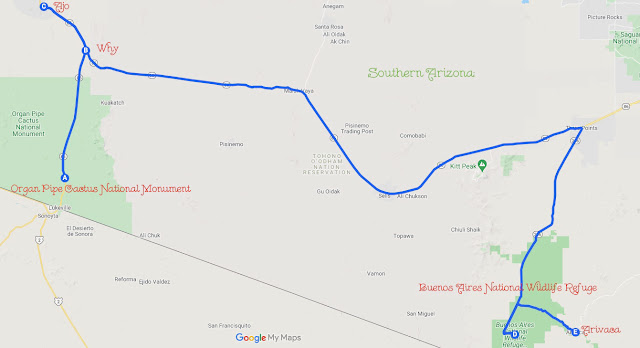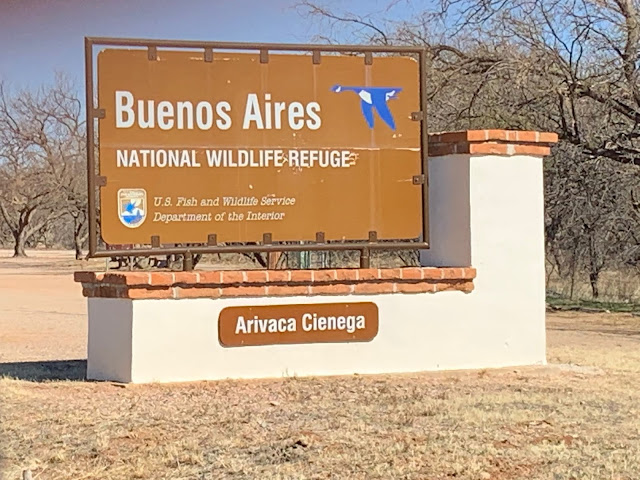Southwest 2021-6: Southern Arizona: Why, Ajo, & Arivaca
En route to Organ Pipe Cactus National Monument, we passed through Why, Arizona. We couldn't pass up a picture, plus, once we had service, the answer to the question, Why is it named Why?The answer is rather logical. It got its name because the original name was merely Y, representing the town's location at a Y intersection. This did not meet the post office's requirement of a minimum of three letters for a name. Thus Y became Why.
Heading to Organ Pipes we also passed through Ajo, which intrigued us, and we decided to visit it on our way out. So that morning after packing the van, we headed north, passing Why (and the Y intersection for our eastern Arizona leg) to this interesting town and the coffee shop we'd seen on our way to Organ Pipes.

...surrounded on three sides by a red-tile roofed white arcade.
At one end of the plaza lie two white churches. On the left is Ajo Federated Church, and on the right is Immaculate Conception Church. Further back is the former Curley School.
With the help of the International Sonoran Desert Allilance, Ajo has been transforming itself into a communicty that celebrates the arts, culture, and conservation.
Murals, mosaics, and parks commemorate the former communities...
On top of this pillar at the entrance to Triangle Park...
...someone had placed a lovely painted stone. We've often seen the tradition of placing stones to honor those who have gone before. It is inexplicably spiritual.
When we were on the Victoria Mine hike in Organ Pipe Cactus National Monument, we'd encountered a woman who extolled Arivaca, so we decided to go there after Ajo. It required passing through yet another Border Patrol checkpoint, although Doug said there are far fewer than when he passed this way in 2014.
En route, we came upon the Buenos Aires National Wildlife Refuge. We wished we’d known of it, for we would have loved to walk its trails. As Patagonia is not that far away we marveled over the choice of names.
Unfortunately Arivaca did not seem to have much to recommend it, due to its out-of-the-way location and perhaps the pandemic. We stopped at the market then went on to a local campground for laundry and showers. Marilyn ignored the sign on the dryer that said it didn't heat, for surely it now worked. Doug turned it by hand for an hour, after which Marilyn hung the clothes across the cab....
At one end of the plaza lie two white churches. On the left is Ajo Federated Church, and on the right is Immaculate Conception Church. Further back is the former Curley School.
Ajo Federated Church
Curley School is now Curley School Artisan Apartments with 30 live/work apartments.We enjoyed coffee and pastries at Oasis Coffee...
...then walked around the plaza.
At the train station, we picked up the walking tour brochure.
Ajo is a former copper mining town. The remaining pit above town is 1,000 feet deep and 1.5 miles wide, and according to the brochure, it is the third largest open pit mine in the world.
Whites lived in the town of Ajo, but on one side of the mine was Mexican town and on the other Indian town. When the mine shut down, the owners destroyed Mexican and Indian towns. Still standing is St Catherine's Indian Mission, which now houses the Ajo Historial Society Museum.With the help of the International Sonoran Desert Allilance, Ajo has been transforming itself into a communicty that celebrates the arts, culture, and conservation.
Murals, mosaics, and parks commemorate the former communities...
...and attempt through "remembering art," to honor their spirit.
...someone had placed a lovely painted stone. We've often seen the tradition of placing stones to honor those who have gone before. It is inexplicably spiritual.
When we were on the Victoria Mine hike in Organ Pipe Cactus National Monument, we'd encountered a woman who extolled Arivaca, so we decided to go there after Ajo. It required passing through yet another Border Patrol checkpoint, although Doug said there are far fewer than when he passed this way in 2014.
En route, we came upon the Buenos Aires National Wildlife Refuge. We wished we’d known of it, for we would have loved to walk its trails. As Patagonia is not that far away we marveled over the choice of names.
Unfortunately Arivaca did not seem to have much to recommend it, due to its out-of-the-way location and perhaps the pandemic. We stopped at the market then went on to a local campground for laundry and showers. Marilyn ignored the sign on the dryer that said it didn't heat, for surely it now worked. Doug turned it by hand for an hour, after which Marilyn hung the clothes across the cab....























Comments
Post a Comment
We love hearing from our readers! If you wish your comment not to be "Anonymous," you can sign into your Google account or simply leave your name at the end of your comment. Thanks!